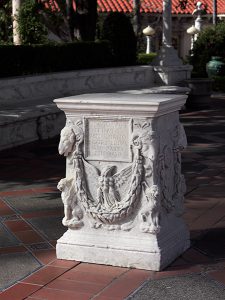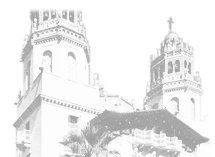Marble, 79-81 AD with late 18th-century lid and repairs
 Ancient Roman workshops produced many small funerary monuments like this one; they could be personalized with an inscription chosen by the patron. This cippus is carved with the name of a father who set it up in his son’s memory. The letter “L” at the upper right corner means that the son was a liberated slave – in Roman society, a freedman. The date is determined by the reference to Emperor Titus Flavius (letters “T FLAV” in the inscription). The sheep’s head on the left and the lid were probably made as restorations in the 18th century with a view to a sale to the 1st marquess of Lansdowne, who amassed the greatest private British collection of antiquities. A descendant auctioned the collection in 1930, and Hearst bought the cippus, which is one of three Roman antiquities on the hilltop that were known in the Renaissance. It was illustrated in two drawings – an Italian sketch c. 1509 by Battista Brunelleschi in the Marucelliana Library, Florence, and a French drawing by Jean-Jacques Boissard c. 1550 in the Royal Library of Sweden – and a print (c. 1600) engraved after Boissard’s drawing. Notations in the drawings and the print record that the cippus was in the church of Saints Cosmas and Damian in Rome. The cippus is displayed on the south side of the Main Terrace at Hearst Castle.
Ancient Roman workshops produced many small funerary monuments like this one; they could be personalized with an inscription chosen by the patron. This cippus is carved with the name of a father who set it up in his son’s memory. The letter “L” at the upper right corner means that the son was a liberated slave – in Roman society, a freedman. The date is determined by the reference to Emperor Titus Flavius (letters “T FLAV” in the inscription). The sheep’s head on the left and the lid were probably made as restorations in the 18th century with a view to a sale to the 1st marquess of Lansdowne, who amassed the greatest private British collection of antiquities. A descendant auctioned the collection in 1930, and Hearst bought the cippus, which is one of three Roman antiquities on the hilltop that were known in the Renaissance. It was illustrated in two drawings – an Italian sketch c. 1509 by Battista Brunelleschi in the Marucelliana Library, Florence, and a French drawing by Jean-Jacques Boissard c. 1550 in the Royal Library of Sweden – and a print (c. 1600) engraved after Boissard’s drawing. Notations in the drawings and the print record that the cippus was in the church of Saints Cosmas and Damian in Rome. The cippus is displayed on the south side of the Main Terrace at Hearst Castle.


